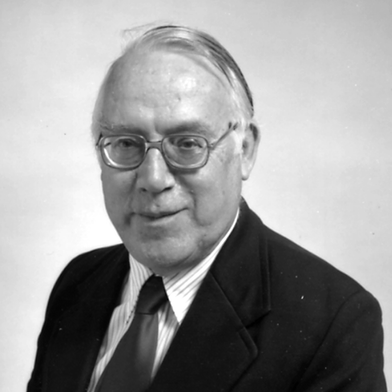Jeffrey B. Harborne FRS. 1st September 1928 – 21st July 2002
Jeffrey Harborne made a major contribution to the development of phytochemistry in the second half of the twentieth century, not only in terms of his original research in the area of anthocyanins and chemical ecology but also in his thorough and scholarly documentation of work on natural products.He was born in Bristol on the 1st September 1928 and educated at Wycliffe College, Stonehouse in Gloucestershire. He won an Open Scholarship to the University of Bristol in 1946 and graduated with honours in chemistry in 1949. His PhD under the supervision of Professor Wilson Baker gave him an introduction to the chemistry of naturally-occurring oxygen heterocycles and formed the chemical basis of his life's work. His PhD led to a new synthesis of isoflavones, the applications of which were described in a number of papers in the Journal of the Chemical Society. He then spent two years (1953–1955) as a post-doctoral fellow with Professor T. A. Geissman working on phenolic plant pigments. He made considerable use of UV spectroscopy in their identification. In these days of NMR spectroscopy, it is hard to realize the importance of UV in natural product identification fifty years ago. Jeffrey Harborne applied not only simple alkali shifts but also the effect of aluminium chloride on the UV absorption, to the identification of the oxygenation pattern of anthocyanins.
In 1955 he returned as a biochemist to the John Innes Horticultural Institute which was then at Bayfordbury in Hertfordshire. He formed links with E. C. Bate-Smith and Tony Swain at Cambridge and established himself as an authority on the application of chromatographic and UV methods to the identification of phenolic plant pigments. He began a series of chemotaxonomic papers on the occurrence of anthocyanins, flavones and aurones in the Primulaceae and in various Antirrhinum and other species.
After a research fellowship (1965–1968) at the University of Liverpool, Jeffrey Harborne moved with Professor Heywood to the University of Reading as a Research Fellow and Reader in the Department of Botany. Here he spent the rest of his very active research career. He was given a Personal Chair in 1976 and became Head and Chairman of the Department of Botany in 1987 until his retirement in 1993 when he became an Emeritus Professor.
Professor Harborne received a number of honours in his career. He was awarded the Gold Medal in Botany of the Linnean Society, the Silver Medals of the Phytochemical Society of Europe and the International Society of Chemical Ecology as well as the Pergamon Phytochemistry Prize in 1993. He was elected a Fellow of the Royal Society in 1995. He has been a prolific writer, having been the author or co-author of some 270 review articles and research papers and author or editor of 40 books. He was an Executive Editor of Phytochemistry from 1972 and its Editor in Chief from 1986 to 1999. Under his guidance this journal grew to become a major publication in the area of plant biochemistry. During his time at Reading he was also Visiting Professor at the University of Rio de Janeiro (1973), University of Texas at Austin (1976), University of California at Santa Barbara (1977) and the University of Illinois at Urbana-Champagne (1981).
 | ||
| Plate1 Jeffrey B. Harborne | ||
In the course of chemotaxonomic research Jeffrey Harborne developed a number of analytical phytochemical methods and applied these to the systematics of anthocyanin distribution in a number of the major plant groups. Many of these methods are described in his useful book ‘Phytochemical Methods’ (J. B. Harborne, Phytochemical Methods: A Guide to Modern Techniques of Plant Analysis, 3rd edn., Kluwer Academic Publishers, Dordrecht, 1998), and he reviewed the discovery of anthocyanins and other flavonoids in a series of articles in Natural Product Reports (J. B. Harborne and C. A. Williams, Nat. Prod. Rep., 2001, 310–333 and previous reviews). His interest in the ecological role of natural products led in 1977 to an influential book, ‘An Introduction to Ecological Biochemistry’ (J. B. Harborne, Introduction to Ecological Biochemistry, 4th edn., Academic Press, London, 1993), which is now in its fourth edition. One could almost date the origin of the science of Ecological Chemistry from the publication of this book. His series of reviews on ‘Recent Advances in Chemical Ecology’ (Nat. Prod. Rep., 1999, 509–523 and previous reviews) in Natural Product Reports extend this book whilst his millenium article in Natural Product Reports surveys twenty-five years of developments in chemical ecology (Nat. Prod. Rep., 2001, 361–379). In his research he collected together a considerable amount of data on the role of flavonoids in insect–plant interactions and he examined the relationship between anthocyanins and pollination ecology. He made a considerable study of the phytoalexins in members of the Leguminosae, Rosaceae and Umbelliferae which include many plants of economic importance. This ecological role of natural products dominated the later years of his research.
Jeffrey Harborne will be remembered for his thorough work on anthocyanins in chemosystematics and for his research in chemical ecology. His many books stand as a monument to his achievements. He was a churchwarden of Christ Church, Reading and he leaves a wife and two sons.
James. R. Hanson
| This journal is © The Royal Society of Chemistry 2002 |
